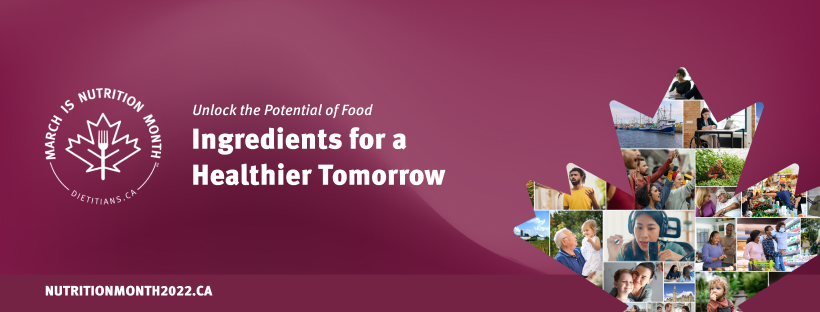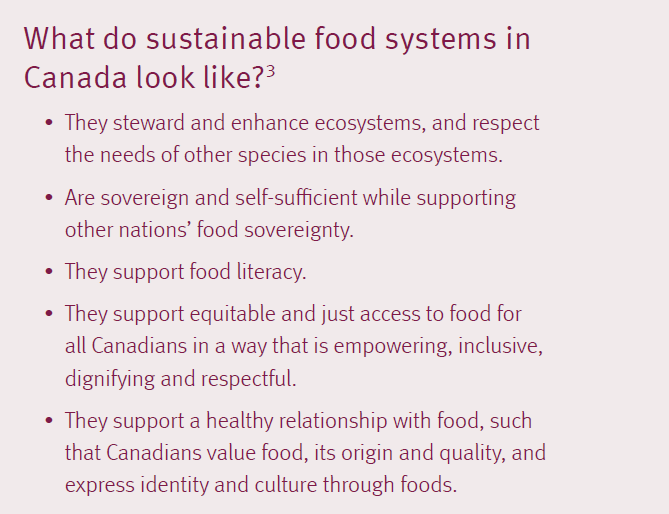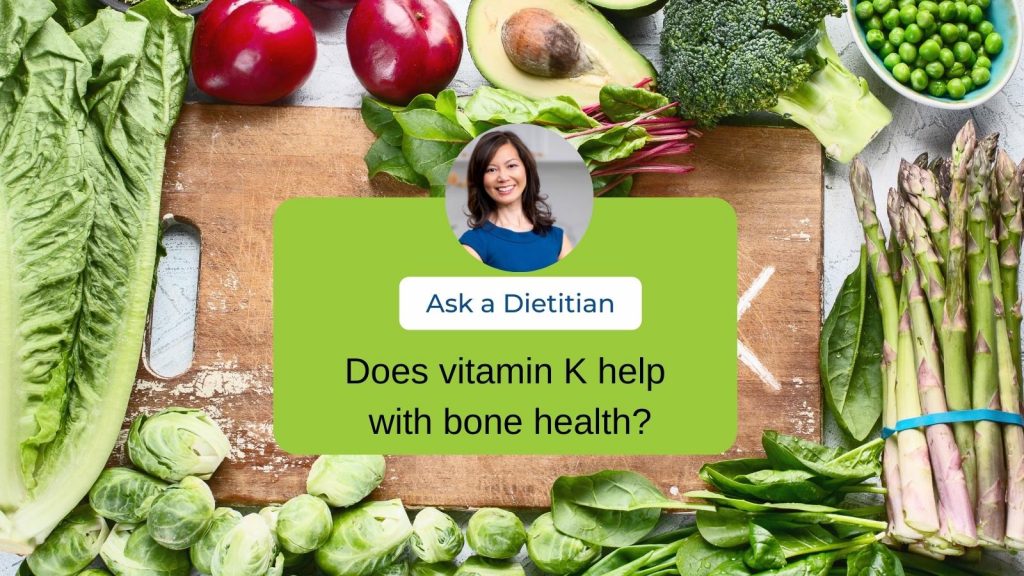 Image Source: Dietitians of Canada
Image Source: Dietitians of Canada
Canadians are looking for healthier ways of eating, a healthier planet and affordable food. To celebrate the 40th annual Nutrition Month, dietitians are focusing on the connection between food, public health and the environment. The sustainability movement has been growing in Canada and around the world. In this blog we define some key ingredients for a healthier tomorrow and sustainable food system.
Key Ingredients for a healthier tomorrow [1]
You probably know that dietitians provide life changing advice on nutrition and food choices to manage illness and promote health. But many dietitians are also involved in these areas of sustainability that could help create a healthier tomorrow.
- Improved Food Security
- “Food and nutrition security exists when all people at all times have physical, social and economic access to food, which is safe and consumed in sufficient quantity and quality to meet their dietary needs and food preferences, and is supported by an environment of adequate sanitation, health services and care, allowing for a healthy and active life.”[2]
- Food Literacy
- “Food literacy includes five main interconnected components: food and nutrition knowledge; food skills; self-efficacy and confidence; food decisions; and external factors such as the food system, social determinants of health, and socio-cultural influences and eating practices.”[3]
- Food Sovereignty
- “Food Sovereignty is the right of peoples to healthy and culturally appropriate food produced through ecologically sound and sustainable methods, and their right to define their own food and agriculture systems.”[4]
- Sustainable Food Choices (Diets)
- “Sustainable Diets are those diets with low environmental impacts which contribute to food and nutrition security and to healthy life for present and future generations. Sustainable diets are protective and respectful of biodiversity and ecosystems, culturally acceptable, accessible, economically fair and affordable; nutritionally adequate, safe and healthy; while optimizing natural and human resources”[5]
- Sustainable Food Systems“
- A food system that delivers food and nutrition security for all in such a way that the economic, social and environmental bases to generate food security and nutrition for future generations are not compromised.”[6] Figure 1 summarizes what sustainable food systems look like in Canada.

Figure 1. Source: Dietitians of Canada (2022) Nutrition Month Activity Guide
How to join the conversation and support action
It can be challenging to know where to start with change towards a healthier you and a healthier planet. The Dietitians of Canada share 5 tips for reducing the environmental footprint of your diet:
- Reduce food waste
Check out our tips to Double down on reducing food waste, Put the freeze on food waste, and - Eat to satisfy your hunger and support your health
Read more tips on 5 smart snacks and What’s Your Food Personality? - Buy local products
Read more about the meaning of local! - Choose a healthy and balanced diet
Read our highlights from a sustainable eating conference - Talk to a dietitian for credible, life changing advice
Read more about Why work with a dietitian?
Do you have a food or nutrition question? Ask us and we’ll feature it in our Ask a Dietitian posts. Registered Dietitians are the most trusted food and nutrition experts who are committed to helping Canadians enjoy nutritious, sustainable, and affordable and healthy eating.
Written by Lucia Weiler, BSc, RD, PHEc, Award-winning dietitian and Co-Founder, n4nn
[1] Dietitians of Canada (2022) Nutrition Month Activity Guide https://www.dietitians.ca/News/2022/Nutrition-Month-2022-Ingredients-for-a-Healthier-T
[2] Committee on World Food Security, Food and Agriculture Organization (2012) https://www.fao.org/3/MD776E/MD776E.pdf
[3] Nutrition Connections. Effective education strategies to increase food and nutrition knowledge in children and youth (2019) https://nutritionconnections.ca/resources/effective-education-strategies-to-increase-food-and-nutrition-knowledge-in-children-and-youth/
[4] What is Food Sovereignty. Food Secure Canada (Accessed 2022) https://foodsecurecanada.org/who-we-are/what-food-sovereignty
[5] Burlingame B, Dernini S. Sustainable Diets and Biodiversity: Directions and Solutions for Policy, Research and Action. (2012) https://www.fao.org/3/i3004e/i3004e.pdf
[6] Nutrition and Food Systems. A report by the High Level Panel of Experts on Food Security and Nutrition of the Committee on World Food Security (2017) https://www.fao.org/fileadmin/user_upload/hlpe/hlpe_documents/HLPE_Reports/HLPE-Report-12_EN.pdf


